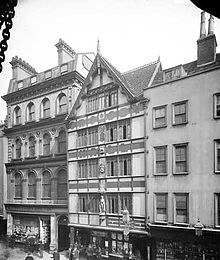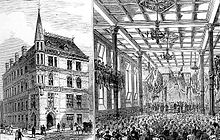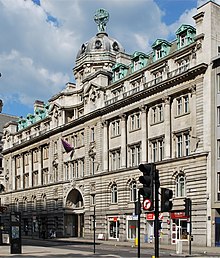London Metropolitan University was formed on 1 August 2002 by the merger of London Guildhall University and the University of North London. In October 2006 the University opened a new Science Centre as part of a £30m investment in its science department at the North campus on Holloway Road, with a "Super Lab" claimed to be one of Europe's most advanced science teaching facilities,[8][9][10] and 280 workstations equipped with digital audio visual interactive equipment.
London Guildhall University
In 1848 Charles James Blomfield, the Bishop of London, called upon the clergy to establish evening classes to improve the moral, intellectual and spiritual condition of young men in London. In response, the bishop Charles Mackenzie, instituted the Metropolitan Evening Classes for Young Men in Crosby Hall, Bishopsgate, London, with student fees at one shilling per session. Subjects on the original curriculum included Greek, Latin, Hebrew, English, History, Mathematics, Drawing and Natural Philosophy. This fledgling college came under royal patronage following the visit of Prince Albert to the classes in 1851. In 1860 the classes moved to Sussex Hall, the former Livery Hall of the Bricklayers' Company, in Leadenhall Street. By this time, some 800 students were enrolled annually.
In 1861 the classes were reconstituted and named the City of London College. Over the next twenty years, the College was one of the pioneers in the introduction of commercial and technical subjects. The college built new premises in White Street at a cost of £16,000 (contributions were received from Queen Victoria and the Prince of Wales) and were opened in 1881. In 1891 the college joined Birkbeck Institute and the Northampton Institute to form the City Polytechnic by a Charity Commissioners' scheme to facilitate funding for these institutions by the City Parochial Foundation, and to enable the three institutions to work cooperatively. However this attempted federation did not function in practice, as each institution continued to operate more or less independently. The City Polytechnic concept was dissolved in 1906 and the City of London College came under the supervision of London County Council.
In December 1940 the college's building was destroyed by a German air raid. City of London College subsequently moved into premises at 84 Moorgate in 1944. In 1948, the City of London College celebrated its centenary with a service of thanksgiving addressed by the Archbishop of Canterbury at St Paul's Cathedral. In 1970 the college merged with Sir John Cass College to form the City of London Polytechnic. In 1977 it also became the home of the Fawcett Society library, afterwards the Women's Library.
Under the Further and Higher Education Act 1992 the Polytechnic was awarded university status (having previously awarded degrees of the Council for National Academic Awards). It was renamed London Guildhall University, to demonstrate its links with the City of London and the City's many guilds/livery companies. It was unassociated with the Guildhall School of Music and Drama, based at the Barbican Centre. It was ranked 30th out of the UK's 43 new universities in the 2001 Research Assessment Exercise. In August 2004, in the midst of a contract dispute with former LGU staff following the merger with the University of North London, it was reported that the management of the merged institution had ordered the destruction of the entire print run of a history of the university – London Guildhall University: From Polytechnic to University – authored by Sean Glynn, formerly a senior research fellow in the department of Politics and Modern History; the work had been commissioned by Sir Roderick Floud, the President of London Metropolitan University, when Provost of LGU.[11]
The former LGU campus, which was home to London Met's Guildhall School of Business and Law until August 2019, was located at the intersection of the City of London financial district and the old East End, near Aldgate East, Tower Hill and Liverpool Street tube stations. There are buildings located at Minories, Jewry Street, Central House, Moorgate, Whitechapel High Street, Calcutta House, Commercial Road and Goulston Street. There is a gymnasium for the use of staff and students at the Whitechapel High St. building,


 London Metropolitan University
London Metropolitan University





















